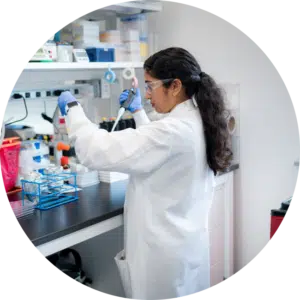OUR SCIENCE | PROTAC DISCOVERY ENGINE
OUR SCIENCE | PROTAC DISCOVERY ENGINE

ARVINAS’ PROTAC Discovery Engine
Forging New Scientific Frontiers in Drug Discovery
From the first paper on targeted protein degradation co-authored by Dr. Craig Crews of Yale University to Arvinas’ founding in 2013, we have firmly established ourselves as a leader in protein degradation research.
Our PROTAC Discovery Engine has led to a robust pipeline, driving some of the most significant breakthroughs in targeted protein degradation within the industry:
- Orally bioavailable degraders
- Degraders that cross the blood-brain barrier in preclinical studies
- First-in-human safety data
- First-in-human pharmacokinetic and pharmacodynamic data
- First-in-human efficacy data


Arvinas’ PROTAC Discovery Engine – The Proof is in the Pipeline
Our PROTAC Discovery Engine creates clinical-stage programs with the potential to help patients:
 E3 KnowledgeBase
E3 KnowledgeBase
Arvinas has deep experience matching the right E3 ligase to the right target. The human body has more than 600 E3 ligases, and Arvinas is expanding our capabilities to include creating novel PROTACs that recruit E3 ligases with targeted expression patterns, such as tumor or central nervous system localized E3 ligases, where they may be beneficial for the development of targeted cancer and neurologic therapies.
Advanced screening capabilities
Arvinas has cutting-edge high-throughput and DNA-encoded library (DEL) screening abilities, powering our ability to identify new target-binding “warheads,” including “undruggable” targets, and new binders for E3 ligases. Unlike traditional libraries, ours are designed specifically to facilitate incorporation into PROTACS and optimize their drug-like properties.
Deep understanding of the “Zone of Ubiquitination”
Understanding how ternary complexes form between PROTACS, target proteins, and E3 ligases is necessary but not sufficient. At Arvinas, we use structural and biochemical information to predict precisely which lysine residues on the target protein can be “tagged” with ubiquitin, and we design PROTACs to exploit this knowledge.
ANGLE: Arvinas Next Generation Linker Evolution
Our privileged linkers incorporate all learnings from Arvinas’ long history of designing PROTACs, allowing increased potency and selectivity right from the start.
Predictive computational modeling
With our deep experience in trimer structure-based computational modeling and design algorithms, we frequently create potent degraders in the first chemical series.
State-of-the-art proteomics capabilities
PROTACs are often far more selective than the targeting warhead. Our proteomics capabilities enable us to understand that specificity in precise detail and iterate quickly to optimize the selectivity of our degraders for the drug target.
 Arvinas Rules
Arvinas Rules
For decades, the long-standing “Rule of 5” has guided small molecule discovery. We have discovered our own proprietary Arvinas Rules to create PROTACs that, for example, are orally bioavailable and cross the blood-brain barrier.
Deep knowledge of in vivo PK/PD and efficacy relationships
Our comprehensive understanding of molecular features that impact PROTAC biodistribution and target degradation in the body enables us to create PROTACs with drug-like properties and activities.



If you’re inspired, please take a look at the current list of opportunities to join our team.
- Cacace, A. Discovery of Brain Penetrant PROTAC Degrader Molecules That Target Pathologic Tau and alpha-Synuclein Protein Species. Presented at: Targeted Protein Degradation Summit. October 24, 2019. Boston, MA.
- Arvinas LLC. Clinical Program Update: ARV-471 & ARV-110. December 14, 2020. New Haven, CT.
- Cacace, A. Discovery of Brain Penetrant PROTAC Degrader Molecules That Target Pathologic Tau and alpha-Synuclein Protein Species. Presented at: Targeted Protein Degradation Summit. October 24, 2019. Boston, MA.
